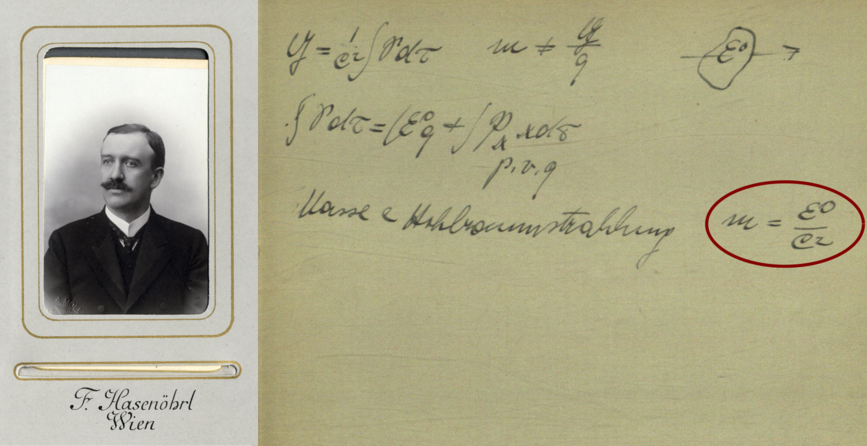This page from lecture notes of a course of special relativity is the beginning of our third bit of history. It reads: “Masse e Hohlraumstrahlung” (Mass e black body radiation), followed by possibly the most famous formula of the whole of physics, the mass-energy equivalence principle:

This equation is one of the greatest breakthroughs introduced by the theory of special relativity and it is generally attributed to Einstein, who introduced it in one of his four ground-breaking contributions of his annus mirabilis in 1905 [1].
The notes reproduced above [2] were taken by Hans Thirring, at that time student in Vienna, around 1911 in the course of special relativity taught by Friedrich “Fritz” Hasenöhrl (1874-1915). It is not generally known that this Viennese physicist, active at the turn of the twentieth century, had conceptually anticipated Einstein’s revolutionary result, up to a numerical factor [6], in a series of papers published in 1904 [3-5]. In fact, Hasenöhrl analysed the properties of blackbody radiation in a moving cavity and derived an “apparent mass” associated to the radiation energy ε0, such that:

Yet, not many today, even in Austria, remember the figure of Hasenöhrl, who however helped a great deal pave the way for modern (theoretical) physics in Vienna. He spent most of his life and career in Vienna: He studied physics at the University of Vienna under Josef Stefan, Ludwig Boltzmann and Franz S. Exner, with whom he completed his Dr. phil. in 1897. After a stay abroad in Leiden as an assistant to the Nobel laureates to be, Heike Kamerlingh-Onnes and Hendrik Lorentz, he came back to Vienna, where, in 1907, he succeeded to Boltzmann’s chair of theoretical physics and become the Director of the “Institut für Theoretische Physik” of the University of Vienna. Thanks to the important result which anticipated the mass-energy equivalence principle, Hasenöhrl acquired an international reputation, being awarded, in 1905, the outstanding Haitinger Prize (after nomination by Boltzmann himself), and participating in the first two prestigious Solvay Conferences in 1911 and 1913. This distinguished career was interrupted when he volunteered in World War I, where he prematurely died, at the age of 40 [7-8].
Hasenöhrl ought to be recalled as a major and long-lasting influence on the landscape of theoretical physics in Vienna, especially on some of his doctoral students, among whom stand the names of Paul Ehrenfest, Hans Thirring, Philipp Frank and the Nobel Prize winner Erwin Schrödinger.
References
[1] Einstein, A. (1905). Ist die Trägheit eines Körpers von seinem Energieinhalt abhängig?. Annalen der Physik, 18 (13): 639–643
[2] Thirring, Hans: Hasenöhrl Relativitätstheorie II. Wien. Österreichische Zentralbibliothek für Physik: https://fedora.phaidra.univie.ac.at/fedora/objects/o:131857/methods/bdef:Book/view
[3] Hasenöhrl, F. (1904). Zur Theorie der Strahlung in bewegten Körpern. Wiener Sitzungsberichte (113): 1039-1055.
[4] Haseöohrl, F. (1904). Zur Theorie der Strahlung in bewegten Körpern. Annalen der Physik (320): 344-370.
[5] Hasenöhrl, F. (1905). Zur Theorie der Strahlung in bewegten Körpern. Annalen der Physik (321): 589-592.
[6] Boughn, S. (2013). Fritz Hasenöhrl and E = mc2. EPJ H (38), 261–278. https://doi.org/10.1140/epjh/e2012-30061-5
[7] Daniela Angetter, D and Martischnig, M. (2005). Hasenöhrl, Friedrich in Biografien österreichischer (Physiker)innen: eine Auswahl. Österreichisches Staatsarchiv.
[8] Österreichische Zentralbibliothek für Physik: https://bibliothek.univie.ac.at/zb-physik-fb-chemie/friedrich_hasenohrl.html

